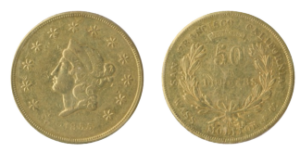Legendary $50 Gold Piece: A Piece of Exciting California Gold Rush History
Posted on — Leave a commentDuring the rough and tumble times of the California gold rush, people in the west desperately needed coins to buy everyday goods and services. Sure, large quantities of gold dust and nuggets were being discovered every day in the early 1850’s. Yet, there was no way to turn these newly discovered riches into coins in the west at that time. After all, the first California branch of the U.S. Mint didn’t open until 1854.
quantities of gold dust and nuggets were being discovered every day in the early 1850’s. Yet, there was no way to turn these newly discovered riches into coins in the west at that time. After all, the first California branch of the U.S. Mint didn’t open until 1854.
During the California gold rush and the ensuing economic boom, people were forced to use pinches of gold dust to pay for things. However, you surely can see how this method lacked uniformity. And the fat fingers from one merchant’s pinch could easily cost you more than expected!
Despite proposals to use paper currency to ease the coin shortage, Californians firmly rejected that idea. In fact, Article IV section 34 of the 1849 California Constitution outlawed the right for any bank to “make, issue, or put in circulation, any bill, check, ticket, certificate, promissory note, or other paper, or the paper of any bank, to circulate as money.”
Bottom line? Californians wanted hard currency.
Private coiners opened up
This created opportunity for enterprising businessman in the private coinage space. Samuel C. Wass and Agoston P. Molitor, Hungarian immigrants who had studied metallurgy in Germany, saw the opportunity and jumped on it.
Wass and Molitor opened an assay office on Montgomery Street in San Francisco in October, 1851.
It didn’t take long before the hardworking Wass and Molitor developed an extensive smelting operation and assay laboratory that was publicly lauded in the local newspapers for its modernity.
The public quickly embraced Wass and Molitor’s coins, which included $5, $10, $20 and $50 gold pieces. Their coins were considered good quality and miners who brought in nuggets and gold dust received fast service – their ore was turned into coins within 48 hours! Their gold pieces demanded a premium in circulation and were eagerly accepted in trade.
The end of an era
The San Francisco Mint began operations in 1854, which halted private gold coinage. But delays were seen in the western mint’s production. In March 1855 a group of prominent merchants and bankers petitioned Wass, Molitor & Co. to resume its coining operations.
Shortly after, Wass, Molitor & Co. resumed its coinage business and produced $10, $20, and round $50 gold pieces. The firm made the decision to replace the unpopular octagonal Assay Office slugs, which had sharp edges that pierced people’s pockets, with a round $50 gold piece.
The 1855 $50 Wass and Molitor gold piece is the largest coin their firm it had ever made – indeed it is a weighty, round $50 gold coin. This giant of the private coinage era is thought to be the only $50 denomination minted by a private firm that was used in circulation.
The round $50 gold pieces remained popular and widely circulated until the San Francisco Mint began striking federal coins in a consistent fashion. By the end of 1855, the private coin firms were no longer needed and Wass, Molitor & Co. shut down.
Once the U.S. Mint finally opened in California, many of these $50 gold pieces ended up in the melting pots due to their high intrinsic value. We have just one of these historic beauties. See it here.
Want to read more? Subscribe to the Blanchard Newsletter and get our tales from the vault, our favorite stories from around the world and the latest tangible assets news delivered to your inbox weekly.








